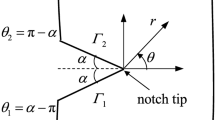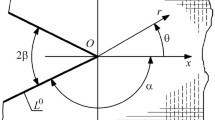Abstract
The singularity of the V-notch in the functionally graded piezoelectric/piezomagnetic (FGPE/PM) material, whose property is varying as a power function along the radial direction, is investigated in this paper. Basing on the assumption that the physical fields around the notch vertex are expressed as the series asymptotic expansions, the singularity characteristic equations for the FGPE/PM V-notch are derived from the equilibrium equation of elasticity and Maxwell equation of electric displacement and magnetic induction. Meanwhile, the mechanical, electrical, and magnetic boundary conditions on the radial face of the V-notch are converted into the combination of the singularity index, characteristic angular function, and its derivative. The interpolation matrix method is introduced to solve the singularity characteristic equations under the given boundary condition. The singularity index, characteristic angular function together with their first- and second-order derivatives can be yielded with the same order accuracy, which can be applied to construct the singular element in the numerical method to evaluate the complete singular physical field around the vertex of the FGPE/PM V-notch. From the numerical testing, it can be found that the first singularity index of the FGPE/PM V-notch decreases with an increase in the inhomogeneous exponent. The opening angle of the V-notch which shows the singularity becomes bigger when the inhomogeneous exponent is increasing. The first singularity index for the anti-plane FGPE/PM V-notch under the free-free boundary condition is greater than the one under the free-clamped boundary condition.







Similar content being viewed by others
Abbreviations
- Oxy :
-
Cartesian coordinate system
- \(Or\theta \) :
-
Polar coordinate system
- \(\alpha \) :
-
Notch opening angle
- M(r):
-
Variation function of the functionally graded piezoelectric/piezomagnetic material property
- \(M_{0} \) :
-
Piezoelectric/piezomagnetic material property
- \(M_{1} \) :
-
Constant parameters
- c :
-
Inhomogeneous exponent
- \(C_{ij0} \) :
-
Elastic stiffness coefficient
- \(e_{ij0} \) :
-
Piezoelectric coupling coefficient
- \(\eta _{ij0} \) :
-
Dielectric permittivity
- \(d_{ij0} \) :
-
Piezomagnetic coupling coefficient
- \(\mu _{ij0} \) :
-
Magnetic permeability
- \(\sigma , \tau \) :
-
Stress components
- \(\varepsilon \) :
-
Strain components
- D :
-
Electric displacement components
- E :
-
Electric field components
- B :
-
Magnetic induction components
- H :
-
Magnetic field components
- \({{\varvec{C}}}_{1} , {{\varvec{C}}}_{2} \) :
-
Elastic stiffness matrix
- \({{\varvec{E}}}_{1} , {{\varvec{E}}}_{2} \) :
-
Piezoelectric coupling coefficient matrix
- \({{\varvec{R}}}_{1} , {{\varvec{R}}}_{2} \) :
-
Dielectric permittivity matrix
- \({{\varvec{D}}}_{1} , {{\varvec{D}}}_{2} \) :
-
Piezomagnetic coupling coefficient matrix
- \({{\varvec{U}}}_{1} , {{\varvec{U}}}_{2} \) :
-
Magnetic permeability matrix
- \(\phi \) :
-
Electric potential
- \(\psi \) :
-
Magnetic potential
- r :
-
Radial distance from the notch tip
- \(A_{k} \) :
-
Expansion coefficients
- \(\lambda _{k} \) :
-
Singularity index
- N :
-
Number of truncated series items, \(\tilde{{u}}_{rk} (\lambda _{k} ,\theta )\),\(\tilde{{u}}_{\theta k} (\lambda _{k} ,\theta )\) Angular functions of the displacement
- \(\tilde{{\phi }}_{k} (\lambda _{k} ,\theta ),\tilde{{\psi }}_{k} (\lambda _{k} ,\theta )\) :
-
Angular functions of the electric potential and magnetic potential
- \(V_{f} \) :
-
Volume fraction of \(\text {BaTiO}_{{3}}\)
- \(K_{ij}^{C} , K_{ij}^{E} , K_{ij}^{M}\) :
-
Material constants of the PE/PM Composite material, \(\text {BaTiO}_{{3}}\) and \(\text {CoFe}_{{2}}\text {O}_{{4}}\)
- \(r, \theta \) :
-
Subscripts index used to represent in the polar coordinate system
- x, y :
-
Subscripts index used to represent in the Cartesian coordinate system
- MEE:
-
Magneto-electro-elastic
- PE/PM:
-
Piezoelectric/piezomagnetic
- FGPE:
-
Functionally graded piezoelectric
- FGPE/PM:
-
Functionally graded piezoelectric/piezomagnetic
References
Wu TL, Huang JH (2000) Closed-form solutions for the magnetoelectric coupling coefficients in fibrous composites with piezoelectric and piezomagnetic phases. Int J Solids Struct 37:981–3009
Duan WH, Wang Q, Quek ST (2010) Applications of piezoelectric materials in structural health monitoring and repair: selected research examples. Materials 3:5169–5194
Ma P, Su RKL, Feng WJ (2016) Integral identities based on symmetric and skew symmetric weight functions for a semi-infinite interfacial crack in anisotropic magnetoelectroelastic bi-materials. Int J Solids Struct 88:178–191
Wu TH, Li XY, Tang HP (2020) Three-dimensional fields in an infinite transversely isotropic magneto-electro-elastic space with multiple coplanar penny-shaped cracks. Int J Eng Sci 159:103434
Nourazar M, Ayatollahi M (2020) Mixed mode analysis of multiple cracks in magneto-electro-elastic plane. Theoret Appl Fract Mech 108:102672
Liu TJC (2009) The singularity problem of the magneto-electro-elastic wedge junction structure with consideration of the air effect. Arch Appl Mech 79:377
Liu TJC, Chue CH (2006) On the singularities in a bi-material magneto-electro-elastic composite wedge under anti-plane deformation. Compos Struct 72:254–265
Xu CH, Xu W, Rong DL, Zhou ZH, Leung YT, Xu XS (2017) A new coupled method for high-accuracy determination of fracture parameters of an interface V-notch in magneto-electro-elastic bi-material. Theoret Appl Fract Mech 92:13–23
Cheng CZ, Cheng X, Niu ZR, Recho N (2016) Singularity characteristic analyses for magneto-electro-elastic V-notches. Eur J Mech A/Solids 57:59–70
Sue WC, Liou JY, Sung JC (2007) Investigation of the stress singularity of a magnetoelectroelastic bonded antiplane wedge. Appl Math Model 31:2313–2331
Zhou ZH, Xu XS, Leung AYT (2013) Hamiltonian analysis of a magnetoelectroelastic notch in a mode III singularity. Smart Mater Struct 22:095018
Chue CH, Liu TJC (2005) Magneto-electro-elastic antiplane analysis of a bimaterial BaTiO3-CoFe2O4 composite wedge with an interface crack. Theoret Appl Fract Mech 44:275–296
Goyat V, Verma S, Garg RK (2018) Reduction in stress concentration around a pair of circular holes with functionally graded material layer. Acta Mech 229:1045–1060
Zhu S, Zhan D, Zhou KC, Li XF (2015) Effects of non-homogeneity on singular electroelastic field near electrodes for a functionally graded piezoelectric material. Eur J Mech A 51:21–28
Choi HJ (2016) Analysis of stress intensity factors for edge interfacial cracks in bonded dissimilar media with a functionally graded interlayer under anti-plane deformation. Theoret Appl Fract Mech 82:88–95
Faal RT, Aghsam A, Milani AS (2015) Stress intensity factors for cracks in functionally graded annular planes under anti-plane loading. Int J Mech Sci 93:73–81
Bagheri R, Ayatollah M, Mousavi SM (2015) Analysis of cracked piezoelectric layer with imperfect non-homogeneous orthotropic coating. Int J Mech Sci 93:93–101
Fotuhi AR, Fariborz SJ (2006) Anti-plane analysis of a functionally graded strip with multiple cracks. Int J Solids Struct 43:1239–1252
Wu CC, Kahn M, Moy W (1996) Piezoelectric ceramics with functional gradients, a new application in material design. J Am Ceram Soc 79:809–812
Shin JW, Lee YS, Kim SJ (2013) An interface crack in a functionally graded piezoelectric bi-layer under anti-plane shear impact. Acta Mech 224:867–879
Rekik M, Elborgi S, Ounaies Z (2012) An embedded mixed-mode crack in a functionally graded magnetoelectroelastic infinite medium. Int J Solids Struct 49:835–845
Rekik M, Elborgi S, Ounaies Z (2014) An axisymmetric problem of an embedded mixed-mode crack in a functionally graded magnetoelectroelastic infinite medium. Appl Math Model 38:1193–1210
Li M, Wu LZ, Feng LP (2009) Surface crack problem for functionally graded magnetoelectroelastic coating-homogeneous elastic substrate system under anti-plane mechanical and in-plane electric and magnetic loading. Eng Fract Mech 76:269–285
Rao BN, Kuna M (2008) Interaction integrals for fracture analysis of functionally graded magnetoelectroelastic materials. Int J Fract 153:15–37
Huang CS, Hu CN (2014) Geometrically-induced singularities in functionally graded magneto-electro-elastic wedges. Int J Mech Sci 89:242–255
Niu ZR, Ge DL, Cheng CZ, Ye JQ (2009) Evaluation of the stress singularities of plane V-notches in bonded dissimilar materials. Appl Math Model 33:1776–1792
Xu XL, Rajapakse RKND (2000) On singularities in composite piezoelectric wedges and junctions. Int J Solids Struct 37:3253–3275
Yao WA, Zhang ZJ, Hu XF (2014) A singular element for reissner plate bending problem with V-shaped notches. Theoret Appl Fract Mech 74:143–156
Huang CS, Chang MJ (2007) Corner stress singularities in an FGM thin plate. Int J Solids Struct 44:2802–2819
Acknowledgements
This work was supported by National Natural Science Foundation of China (Nos. 12172114, 11772114) and the Fundamental Research Funds for the Central Universities (No.PA2019GDQT0016).
Author information
Authors and Affiliations
Corresponding author
Additional information
Publisher's Note
Springer Nature remains neutral with regard to jurisdictional claims in published maps and institutional affiliations.
Appendices
Appendix A
The characteristic ordinary differential equation, such as Eqs. (8) and (17), can be written in a general form as follows:
where the superscript j denotes the \(j\;\text {th}\) order derivative with respect to \(\theta \), \(g_{j} (\theta )\) and \(q_{j} (\theta )\) are the coefficients which depend on \(\theta \), and m is the highest order derivative of \(\tilde{{w}}_{k} (\theta )\).
The boundary condition, such as Eqs. (10) and (21), can also be written in a general form as follows:
where \(\alpha _{j} \) and \(\beta _{j}\) are the corresponding coefficients.
The interval \(\theta \in [-\theta _{1} ,\theta _{1} ]\) is uniformly divided into n subintervals at divisions \(\theta _{(0)} ,\theta _{({1})} ,\ldots ,\theta _{(n)} \), where \(\theta _{(0)} =-\theta _{1} \) and \(\theta _{(n)} =\theta _{1} \). The application of Eq. (23) at each division yields
where \({{\varvec{W}}}_{k}^{(j)} (\theta )=(\tilde{{w}}_{k}^{(j)} (\theta _{(0)} ),\tilde{{w}}_{k}^{(j)} (\theta _{({1})} ),\ldots ,\tilde{{w}}_{k}^{(j)} (\theta _{(n)} ))^\mathrm{{T}}\). The \(\tilde{{w}}_{k}^{(j-1)} (\theta )\) can be integrated by \(\tilde{{w}}_{k}^{(j)} (\theta )\) as
and \(\tilde{{w}}_{k}^{(j)} (\theta )\) can be approximated using the Lagrangian polynomial function \(L_{m} (\theta )\) as
Thus, the recurrence relation of Eq. (26) for an arbitrary jis in the form as follows:
where \({{\varvec{W}}}_{k0} =(\tilde{{w}}_{k} (\theta _{0} ),{\tilde{{w}}}'_{k} (\theta _{0} ),\ldots ,\tilde{{w}}_{k}^{(m-1)} (\theta _{0} ))^{{T}}\) and \({{\varvec{D}}}\) is the interpolating integral matrix.
By substituting Eqs. (28) into (25), the following algebraic equation can be obtained:
The boundary condition (24) can be discretized and written as the algebraic equation in a similar manner as follows
Once the system of equations (29) and (30) is solved by the numerical method such as QR method, one can get a finite term of the singularity index \(\lambda _{k} \) and corresponding characteristic angular functions \(({{\varvec{W}}}_{k0} ,{{\varvec{W}}}_{k}^{(m)} )^\mathrm{{T}}\).
Appendix B
Rights and permissions
About this article
Cite this article
Yang, Y., Cheng, C., Yao, S. et al. Singularity analysis for the V-notch in functionally graded piezoelectric/piezomagnetic material. J Eng Math 132, 17 (2022). https://doi.org/10.1007/s10665-021-10198-0
Received:
Accepted:
Published:
DOI: https://doi.org/10.1007/s10665-021-10198-0




